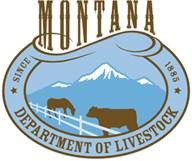The Montana Department of Livestock has adopted changes to rules affecting vaccination requirements
The newly adopted brucellosis vaccination rule (ARM 32.3.433) mandates that eligible animals in 10 Montana counties must be vaccinated against brucellosis. The change requires that all sexually intact female cattle and domestic bison 12 months of age or older in Beaverhead, Big Horn, Broadwater, Carbon, Gallatin, Jefferson, Madison, Park, Stillwater, and Sweet Grass Counties must be brucellosis vaccinates. Prior to this rulemaking, only cattle and domestic bison in Gallatin, Madison, Park, and Beaverhead Counties were required to be vaccinated. This rule includes cattle that enter any of these counties for seasonal grazing.
Beyond the addition of new counties, the rule also moves away from December 1st as the cutoff date for completion of vaccination and no longer specifies that animals be calf-hood vaccinates. This gives producers more options for the management of replacement heifers and allows animals to be vaccinated as adults.
“Vaccination in a broader area than Montana’s DSA provides some protection from sudden changes to the distribution of infected wildlife on the landscape,” said Eric Liska, brucellosis program veterinarian with MDOL. “Vaccination has been shown to minimize the spread of the disease if it is introduced into a livestock herd.”
Producers who have not vaccinated their replacement females in the past should contact their local veterinarian to schedule replacement heifer vaccinations and discuss options for unvaccinated adult females in the herd.
Additionally, changes to ARM 32.3.433 adjusts the DSA boundary in a portion of Beaverhead County. Cattle and domestic bison that utilize this area will be subject to all brucellosis DSA regulations. DSA regulations include brucellosis testing prior to a change of ownership and movement as well as vaccination and identification requirements.
The DSA boundary has expanded 3 times since 2009. Each expansion was made in response to findings of brucellosis in elk which required the inclusion of additional cattle and domestic bison in the surveillance program. The undetected disease spread outside of Montana’s DSA could jeopardize Montana’s federal brucellosis Class Free status, and in 2008, a loss of brucellosis Class Free status was estimated to have cost Montana’s producers up to $11.5 million annually. DSA regulations and producer compliance have allowed for early disease detection when a periodic transmission from wildlife to livestock does occur. This success promotes trading partner confidence in the disease-free status of Montana’s livestock.
The mission of the Montana Department of Livestock is to control and eradicate animal diseases, prevent the transmission of animal diseases to humans, and to protect the livestock industry from theft and predatory animals. For more information on the Montana Department of Livestock, visit www.liv.mt.gov.









Public Comment Period and Meetings on Bison Management
Image via nps.org
There are a number of bison planning efforts underway that impact the state of Montana and so MSGA is providing a brief update on these planning documents and how members can become involved. The first effort is between the National Park Service (NPS) and the State of Montana, who are serving as joint lead agencies in the preparation of an Environmental Impact Statement (EIS) for a plan to manage Yellowstone-area bison. As stated in their documents, the goal is to minimizing brucellosis transmission between these wild bison and livestock to the extent practicable.
NPS and State of Montana will be hosting a series of three public scoping open houses in Bozeman, Gardiner, and West Yellowstone, Montana. The open houses will have an identical format and agenda. The meetings will be held in Bozeman on June 2 at the Hilton Garden Inn, Gardiner on June 3 at the Gardiner School, and West Yellowstone on June 4 at the Holiday Inn. Each meeting will run from 6 to 8 p.m. and have an identical agenda.
This document planning process is in the scoping phase, which is the first opportunity to provide comments. The comment deadline is June 15, 2015. Comments can be submitted online at NPS Planning, Environment & Public Comment or by mail to:
Yellowstone National Park
Yellowstone Bison Management Plan EIS
PO Box 168
Yellowstone National Park, WY 82190
There are currently six preliminary draft alternatives, ranging from No Action alternative to year-round bison tolerance. This EIS is designed to update the 2001 Interagency Bison Management Plan (IBMP).
MSGA is currently reviewing these draft alternatives and will provide talking points to members and submit comments to the NPS. Even though this is the first phase in the planning process, MSGA has been active in communication with our Congressional delegation, APHIS and MT state agencies over impacts of bison to our members.
In addition, MT FWP is finalizing a Statewide Bison Conservation and Management EIS. FWP has stated the development of this EIS is to address the potential for bison restoration in Montana. There have been four draft alternatives developed, ranging from No Action to bison being restored on public lands. FWP plans to release a draft in late May, followed by a 90-day comment period. MSGA, along with a number of members, attended a series of meeting held by FWP to discuss the development of this EIS. MSGA will once again be very involved in commenting on this document and providing talking points to members, upon its release.
Click here to visit the NPS website and learn more about Yellowstone’s Bison Management Plans.